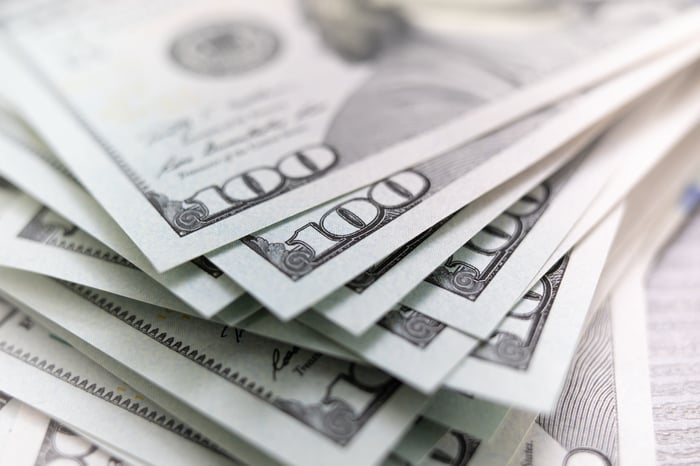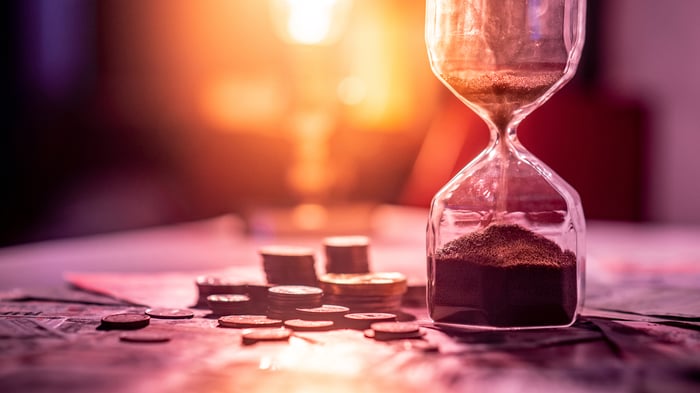This year has represented quite the adventure for Wall Street and investors. While volatility never quite goes away when investing, we've had about a decade's worth of wild vacillations crammed into a four-month period, all thanks to the coronavirus disease 2019 (COVID-19) pandemic.
However, history has also taught investors that putting your money to work during periods of panic tends to work out nicely. Despite the broadly based S&P 500 undergoing 38 corrections of at least 10% since the beginning of 1950, each and every one of these declines, save for the current correction, has eventually been erased by a bull market rally.

Image source: Getty Images.
But there's a big difference between just paralleling the returns of the benchmark S&P 500 -- which in itself isn't bad at a 7% annual average return, inclusive of dividend reinvestment -- and running circles around the widely followed index. For one stock, a minuscule investment of $100 in 1964 would have been worth an eye-popping $2.74 million, as of the end of 2019.
Ladies and gentlemen, meet conglomerate Berkshire Hathaway (BRK.A 0.36%) (BRK.B 0.21%).
Although Berkshire Hathaway isn't exactly what you'd call a household name, its CEO, Warren Buffett, is certain to ring a bell or two with investors. Buffett is one of the richest people in the world, with a net worth of almost $72 billion. Mind you, this figure would almost certainly be well beyond $100 billion had Buffett not generously donated tens of billions to charity over the years.
Since 1965, Buffett has led Berkshire Hathaway to an average annual return of 20.3%. This compares to an annual average return of 10% on the nose for the S&P 500, including dividends, over this same period. This 10.3% average annual return gap may not sound like much, but compounded over 55 years the difference equates to an aggregate gain of 19,784% for the S&P 500 and 2,744,062% for Berkshire Hathaway. That's what we call running circles around the stock market.
Obviously, Buffett has played a big role in Berkshire Hathaway's enormous outperformance over the past 55 years. Let's take a closer look at some of the specifics that allowed Berkshire Hathaway to make its shareholders rich.

Image source: Getty Images.
Buffett buys companies with the intent of holding them for a very long time
First of all, Buffett is a big fan of long-term investing. While there will undoubtedly be some anomalous buying and selling in Berkshire Hathaway's investment portfolio, Buffett predominantly buys companies that he believes have sustainable competitive advantages (i.e., moats), and intends to hold these businesses for extensive periods of time. Some of his top-performing investments also happen to be a number of the longest-tenured.
For instance, Coca-Cola (KO 0.78%), Wells Fargo and American Express have been consistent holdings for Berkshire Hathaway over the past 32, 31, and 27 years, respectively. The power of compounding is incredible, but it requires time as the key ingredient. Buffett is willing to give many of his investments the proper time to blossom, whereas most money managers fail to do so.

Image source: Getty Images.
Buffett's narrow research focus has made him an expert in select sectors
Although it's been a bit of a crutch over the past decade given that tech stocks and biotech have been considerable outperformers, Buffett can place a significant portion of his company's success on his narrow research focus.
More specifically, the Oracle of Omaha is a master at spotting value in the financial sector and among consumer staples. Bank stocks have long been Buffett's favorite investment, with more than a dozen holdings of Berkshire's 46-security portfolio currently belonging to the financial sector. Any industry that makes copious amounts of sustainable profit during periods of economic expansion tends to make Buffett happy.

Berkshire Hathaway CEO Warren Buffett at his company's annual shareholder meeting. Image source: The Motley Fool.
Berkshire Hathaway is tied to the health of the U.S. economy
That leads me to my next point: Warren Buffett is a big fan of aligning Berkshire Hathaway's success up with that of the U.S. economy.
Berkshire generates income two separate ways. It has its aforementioned 46-security investment portfolio, but has also acquired approximately 60 businesses over the past five decades. These acquired businesses, and Berkshire's investment portfolio, represent a wide swath of sectors and industries. However, many of these companies and holdings are cyclical in nature. This is a fancy way of saying that they do well when the U.S. economy is doing well, and vice versa during a recession.
While recessions and economic contractions are a natural part of the economic cycle, Buffett understands that periods of expansion are far lengthier than periods of contraction. By aligning Berkshire Hathaway with the U.S. economy, he's allowed his company to bask in fruits of extended bull markets, while weathering generally short bursts lower in the broader economy.

Image source: Getty Images.
The Oracle of Omaha is a huge fan of dividend income
Finally, Buffett is a big fan of sitting back and collecting an incredible amount of dividend income. Admittedly, the COVID-19 crisis has put a serious crimp in Buffett's income stream, with hundreds of millions of dollars in dividends now gone due to companies reducing or eliminating their payouts. Nevertheless, Berkshire Hathaway remains on track to collect close to $4 billion in annual dividend income.
That's the other thing about long-term investing: yield on cost can go through the roof! With an initial cost basis on Coca-Cola of around $3.25 a share, and Coca-Cola paying out $1.64 in dividends annually, Berkshire is collecting an annual yield, based on its original cost, of 50.5%! Berkshire's yield on cost also tops 20% for American Express and analytics company Moody's.
It's all of these reasons, combined, that investors have been able to grow an initial $100 investment in Warren Buffett's company into more than $2.7 million.





